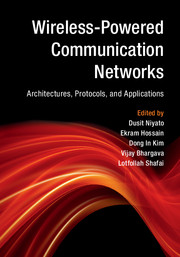Book contents
- Frontmatter
- Contents
- List of contributors
- Preface
- Part I Basics of Wireless Energy Harvesting and Transfer Technology
- Part II Architectures, Protocols, and Performance Analysis
- Part III Applications of Wireless Energy Harvesting and Transfer
- 9 Sensor Networks with Wireless Energy Harvesting
- 10 Cognitive Radio Networks with Wireless Energy Harvesting
- 11 Mobile Ad-Hoc Networks and Delay-Tolerant Networks With Wireless Energy Harvesting
- Index
- References
9 - Sensor Networks with Wireless Energy Harvesting
from Part III - Applications of Wireless Energy Harvesting and Transfer
Published online by Cambridge University Press: 01 December 2016
- Frontmatter
- Contents
- List of contributors
- Preface
- Part I Basics of Wireless Energy Harvesting and Transfer Technology
- Part II Architectures, Protocols, and Performance Analysis
- Part III Applications of Wireless Energy Harvesting and Transfer
- 9 Sensor Networks with Wireless Energy Harvesting
- 10 Cognitive Radio Networks with Wireless Energy Harvesting
- 11 Mobile Ad-Hoc Networks and Delay-Tolerant Networks With Wireless Energy Harvesting
- Index
- References
Summary
Introduction
Current deployment of large-scale sensor networks either employs miles of cabling for providing electrical power, or battery-powered wireless sensors, which gives rise to a serious environmental problem with the disposal of a huge amount of used batteries [1]. The recent progress in wireless energy transfer and harvesting techniques [2, 3] has provided an alternative way to address the energy limitations of traditional wireless sensor networks.
In this chapter, the strategies of energy replenishment for wireless-powered sensor networks are overviewed in detail. Generally, there are two types of solution, i.e., through static wireless charger deployment and mobile charger dispatch [4]. The existing strategies with regard to the two types of solutions are reviewed and discussed. Then, the hardware design principles for sensor circuits are also outlined. Finally, we introduce wireless energy transfer scheduling designed using centralized and distributed approaches, and future research directions are discussed.
Static Wireless Charger Deployment
In sensor networks, the energy supply is limited. Wireless energy transfer and harvesting techniques have been adopted to supply energy to sensor nodes. In particular, a wireless charger is used in sensor networks to supply energy to multiple sensors simultaneously. Thus, optimal deployment of wireless chargers is an important issue. Wireless charger deployment concerns the planning of charger locations. The goal is to provide sufficient energy to wireless sensors in the network. We can divide wireless charger deployment problems into two categories. The first category is static charger placement, in which case, after having been deployed, the chargers remain at the same locations. The second category is mobile charger placement. The charger can move, and hence the deployment optimizes the path of the charger's motion. Wireless charger deployment is important because the charging range is limited, e.g., to a few meters for coupling-based wireless chargers and tens of meters for RF-based chargers. Thus, the deployment must be optimized to meet the energy demand of the wireless sensor networks. Especially in a large-scale network, deploying chargers to support all sensor nodes is too costly and has too high an overhead. An efficient method has to be devised [5]. As shown in Figure 9.1, we have four scenarios for existing wireless charger deployment strategies that have been addressed in the literature.
- Type
- Chapter
- Information
- Wireless-Powered Communication NetworksArchitectures, Protocols, and Applications, pp. 291 - 337Publisher: Cambridge University PressPrint publication year: 2016
References
- 1
- Cited by



